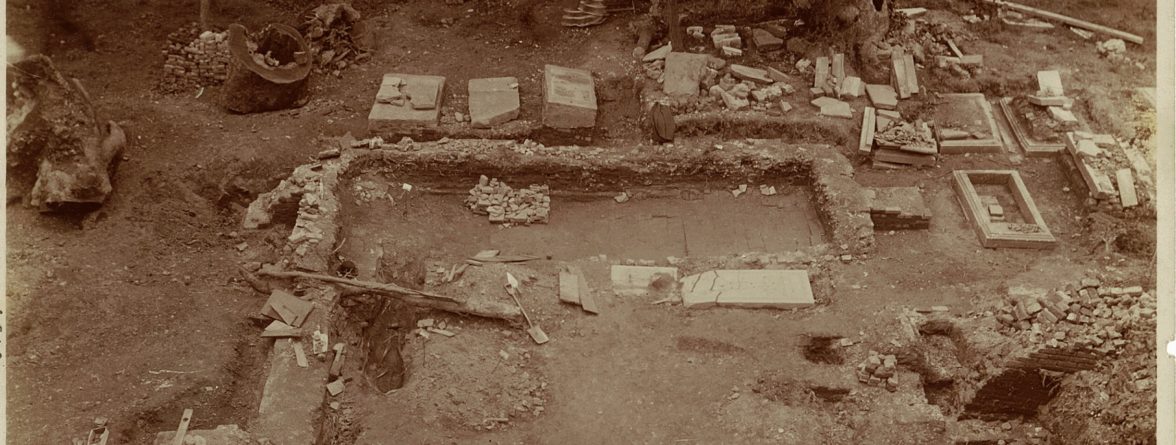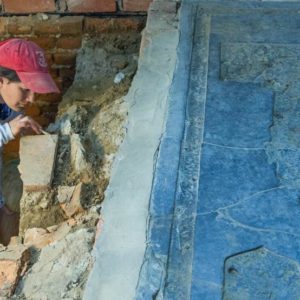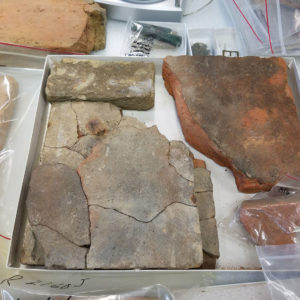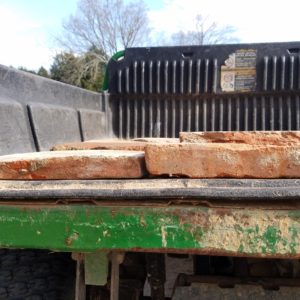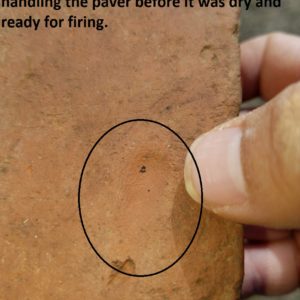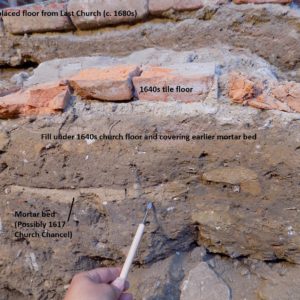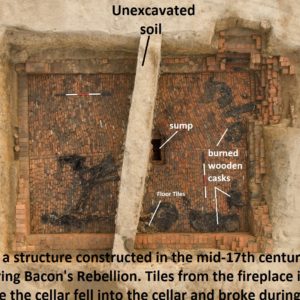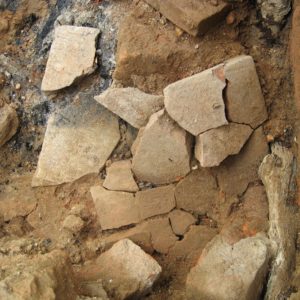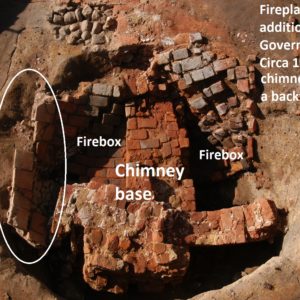With only a few months remaining in the excavation schedule, the Jamestown Rediscovery team continues to search within the 1907 Memorial Church for the three 17th-century churches. Rediscovery’s goals are to identify the floor plan of the original 1617 church, and to identify two later 17th century churches in the same location. Colonists constructed the second church of brick in the 1640s, and then a third church of brick after fire destroyed portions of the 1640s church during Bacon’s Rebellion on September 19, 1676.
The 1617 chancel and choir are of primary significance because this is where the first legislative assembly met in 1619. Secretary John Pory wrote in 1619, “The most convenient place we could finde to sitt in was the Quire of the Churche.” Governor Sir George Yeardley, his Council of Estate, the Secretary, Clerk, the Sergeant, all of the Burgesses, and the Reverend Bucke convened in this location. New exhibits in the Memorial Church slated to open in 2019 will focus on the 1617 structure and the historic event that occurred within its walls 400 years ago. Archaeology is providing the clues for the interpretation and recreation of the floor on which those early representatives walked and stood.
Before Rediscovery excavations began, the team reviewed notes and photographs taken by Mary Jeffery Galt, Annie Galt, and Mary Winder Garrett of the Association for the Preservation of Virginia Antiquities (APVA) (now Preservation Virginia) during their 1897 to 1902 digs. Though sometimes confusing, their records proved invaluable. Shortly after clearing the overgrown vegetation in the area adjacent to the church tower, they uncovered the 1640s brick church foundations. They also exposed a surviving brick tile floor in the east end, which marked the paved chancel of the last church.
Unfortunately, much of the chancel tilework described in the APVA reports was disturbed during their excavation of the graves below. Fragments of various mortars and pavers from portions of once intact floors littered their backfill. When the APVA excavators finished digging, they used cement to replace the tiles in an attempt to duplicate how they found the floor. Rediscovery’s analysis of the cemented tiles revealed that many were likely recycled from an earlier chancel floor, while scant evidence of the first chancel floor was uncovered. Although analysis is preliminary at this time, parallels between the tiles in the church and other dateable structures on the site are noteworthy and may provide dates for the church floors.
For instance, intact brick tiles found east of the Knight’s Tombstone measure from approximately 8″ by 8″ to 8½″ by 8½″, and they are two different thicknesses: 1” and 1 ½”. Most of the thicker tiles have beveled edges. Nail holes in some corners and centers provide manufacture evidence; nails kept the handmade tiles separate during production. Excavations in 2008 of Structure 180, a mid-17th-century cellar destroyed during Bacon’s Rebellion, revealed tiles of similar dimensions and thicknesses. These similarities suggest this chancel floor was built at a later time, thus associated with the 1640s church.
Then, in a section of mortar below the 1640s chancel floor, instead of tiles, archaeologists found in situ mortar joints that reveal the tile dimensions and the pattern in which they were laid. The outlines suggest they were approximately 7½″ by 7½″ square and 1½″thick, and that they were placed in a running, or side by side, pattern. In 2005, Rediscovery archaeologists discovered similar tiles in a ca. 1617 hearth in Structure 176. The chimney is part of an addition to Lt. Governor Samuel Argall’s residence. It is notable that Argall also oversaw the construction of the 1617 church! While interpretations are preliminary at this time, it is hoped that with this evidence in hand, a floor resembling the original 1617 church floor can be built. On this reconstructed floor, visitors will be able to stand in the exact location where the First General Assembly met in the English New World 400 years ago!
related images
- This 1901 photo of the church excavations shows intact tiles in the chancel for the last church.
- Mary Anna Hartley excavates a section of surviving chancel floor in preparation for the removal of the Knight’s Tombstone (on right). Evidence suggests that this floor relates to the 1640s brick church. The burned wood and plaster found resting directly on some of the tiles relates to the fire that burned that church during Bacon’s Rebellion in 1676.
- Burned tiles from the mid-17th century cellar mended in the Rediscovery lab
- These tiles were likely part of the 1640s church chancel floor. Note the notches in the corners and middle.
- Tiles being moved from the site
- Possible nail hole in the tile
- Thumbprint found on one of the tiles from where one of the brick makers was handling the paver before it was dry and ready for firing
- Features in the church floor
- Mortar bed for the earliest floor found in the chancel. Joint lines and tile impressions indicate that these pavers were laid side by side. Possibly the chancel for the 1617 church.
- A cellar for a structure constructed in the mid-17th century and burned during Bacon’s Rebellion. Tiles from the fireplace in the room above the cellar fell into the cellar and broke during the fire.
- Tile on floor for possible fireplace apron
- Fireplace in Argall’s addition to the Governor’s House, c. 1617. The chimney sunk into a backfilled well.


